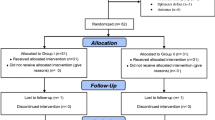Abstract
Background
The posterior trans-sphincteric approach to treat different lesions of the rectum has been known since the last century. Although there are many advantages to this procedure, it has never been widely accepted because many surgeons fear its potential postoperative complications. The purpose of this study is to reevaluate the role of this conventional approach to surgery of the rectum from the authors’ 16 years experience.
Methods
Data were collected retrospectively from clinical records of 102 patients with mid- to low-lying rectal neoplastic disease treated by a single surgeon using a posterior trans-sphincteric approach to the rectum at Peking Union Medical College Hospital, China, between August 1990 and August 2006. The Williams incontinence scale of every patient was assessed preoperatively and postoperatively and the results were analyzed.
Results
Forty men and 62 women with a median age of 55.5 years (range = 21–87 years) underwent this approach. Their preoperative anal continence was assessed as grade 1 in 98 and grade 2 in 4. Indications for surgery were rectal villous adenoma in 36, early rectal carcinoma in 43, advanced rectal carcinoma in 10, and rectal submucosal neoplastic disease in 13. The median operating time, blood loss, and postoperative hospital stay were 75 min (range = 40–180 min), 60 ml (range = 0–300 ml), and 8 days (range = 7–60 days), respectively. All 102 rectal neoplastic diseases achieved complete excision (partial rectectomy in 96, segmental rectectomy in 6), and the resection margins were all clear. Three patients (2.9%) developed postoperative wound infection, and 4 patients (3.9%) developed fecal fistula. Thirty-three patients (32.4%) developed postoperative initial incontinence to flatus (n = 26) or liquid stool (n = 7) within 1 week. Three months after the operation, 94 patients (92.2%) achieved grade 1 continence and only 8 patients (7.8%) had occasional episodes of flatus incontinence. No patient developed postoperative anal stricture. There was no operation-related mortality. Three patients (2.9%) developed local tumor recurrence during median follow-up of 76.8 months (range = 10–192 months).
Conclusion
The posterior trans-sphincteric approach is suitable for mid- to low-lying rectal lesions amenable to treatment using local therapy.





Similar content being viewed by others
References
Mason AY (1970) Surgical access to the rectum–a transsphincteric exposure. Proc R Soc Med 63(suppl):91–94
Mason AY (1974) Trans-sphincteric surgery of the rectum. Prog Surg 13:66–97
Mason AY (1977) Transsphincteric approach to rectal lesions. Surg Annu 9:171–194
Madsen HH, Kronborg O (1987) Posterior transsphincteric rectotomy. Indications and safety. Dis Colon Rectum 30:939–941
Qiu HZ (1993) Posterior transsphincteric approach for the surgery of the rectum. Zhonghua Wai Ke Za Zhi 31:124–126
Williams NS, Patel J, George BD et al (1991) Development of an electrically stimulated neoanal sphincter. Lancet 338:1166–1169
Qiu HZ, Tang WS, Zhu Y (1995) The transphincteric approach excision of rectal villous adenomas. Zhonghua Wai Ke Za Zhi 33:170–172
Qiu HZ, Lin GL, Wu B et al (2006) Transsphincteric surgery of rectal lesions: a report of 120 cases. Zhonghua Wei Chang Wai Ke Za Zhi 9:114–116
Qiu HZ, Wu B, Lin GL et al (2007) Therapeutic effects of transsphincteric surgery in treating rectal tumors: a report of 97 cases. Zhonghua Wai Ke Za Zhi 45:1167–1169
Bevan AD (1917) Carcinoma of rectum–treatment by local excision. Surg Clin North Am 1:1233–1239
David VC (1943) The management of polyps occurring in the rectum and colon. Surgery 14:387–394
Larkin MA (1959) Transsphincteric removal of rectal tumors. Dis Colon Rectum 2:446–451
Oh C, Kark AE (1972) The transsphincteric approach to mid and low rectal villous adenoma: anatomic basis of surgical treatment. Ann Surg 176:605–612
Terkivatan T, den Hoed PT, Lange JF Jr et al (2005) The place of the posterior surgical approach for lesions of the rectum. Dig Surg 22:86–90
Lin GL, Meng WCS, Lau PYY et al (2006) Local resection for early rectal tumours: comparative study on transanal endoscopic microsurgery (TEM) versus posterior trans-sphincteric approach (Mason’s Operation). Asian J Surg 29:227–232
Rothenberger D, Garcia-Aguilar J (2005) Rectal cancer: local treatment. In: Fazio VW, Church JM, Delaney CP (eds) Current therapy in colon and rectal surgery, 2nd edn. Elsevier-Mosby, Philadelphia, pp 179–184
Kulig J, Richter P, Gurda-Duda A et al (2006) The role and value of endorectal ultrasonography in diagnosing T1 rectal tumors. Ultrasound Med Biol 32:469–472
Nastro P, Beral D, Hartley J et al (2005) Local excision of rectal cancer: review of literature. Dig Surg 22:6–15
Gall FP, Hermanek P (1992) Update of the German experience with local excision of rectal tumors. Surg Oncol Clin N Am 1:99–109
Pena A, Amroch D, Baeza C et al (1993) The effects of the posterior sagittal approach on rectal function (experimental study). J Pediatr Surg 28:773–778
Author information
Authors and Affiliations
Corresponding author
Rights and permissions
About this article
Cite this article
Qiu, HZ., Lin, GL., **ao, Y. et al. The Use of Posterior Trans-Sphincteric Approach in Surgery of the Rectum: A Chinese 16-Year Experience. World J Surg 32, 1776–1782 (2008). https://doi.org/10.1007/s00268-008-9630-9
Published:
Issue Date:
DOI: https://doi.org/10.1007/s00268-008-9630-9




